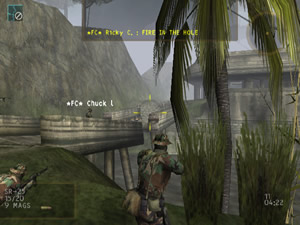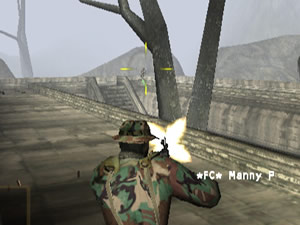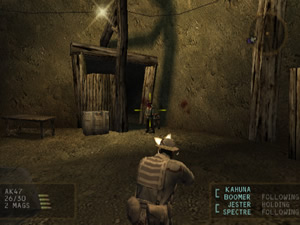Sealing Sony’s Deal.
Long before Jesse “The Body” Ventura took over Minnesota, he was hurling
himself out of airplanes, holding his breath for 20 minutes at a time, crawling
through muck and lobbing grenades at rats as a
member of the U.S. Navy Seals, the most lethal fighting unit the US has to
offer. Jesse spit lead. He bled oil. He crapped shrapnel. He was, for all intents
and purposes, tougher than your dad, even.
Then, he spent a decade wearing
pink suits and yellow boas while chasing half-naked men around a ring. Guess
it’s true that war puts a man through many changes.
Thankfully,
that kind of turnaround probably won’t happen to you after playing SOCOM:
US Navy Seals, though you will likely need some military-grade help removing
your ass from the couch. As the first official online game for the PS2, SOCOM
does its job well despite not doing much different.
SOCOM is a first/third-person tactical action game that puts you in
the wet, well-worn shoes of a US Navy Seal. Through a nicely orchestrated single-player
campaign, it’s your duty to coordinate missions by leading two teams of seals
into dangerous scenarios.
But while this seems pretty standard on paper, the game is helped tremendously
by the included headset, which allows you to communicate with your team members
by actually talking to them. Revolutionary? Not really. Darn cool? Hell yes.
You and your partner make up Alpha team, while two other Seals make up Bravo
team. By pressing the Circle button and talking into the comfy headset (made
by the experts at Logitech), you can give orders to any team members to do a
variety of actions, such as “Follow” or “Fire at Will” or a combination of several
commands, such as the helpful “Breach, Bang and Enter.”
For instance, one of your mission objectives (there are often many on a map)
might be to secure a building by eliminating all enemies inside. You can tell
Bravo team to “Deploy Bang” and watch them hurl a flashbang grenade at the door.
You can have them stay in their place and snipe anyone coming out to flank you.
You can ask them to “Cover the Area” to make sure things are mellow once you
reemerge from the building. You can ask them to do all kinds of stuff, in fact,
and for the most part, they’ll obey.
The headset is also used to receive incoming messages from your superiors
or teammates, which is a really cool effect that draws you into the game. You’ll
get little messages in your ear while everyone else in the room doesn’t hear
a thing. It’s like being schizophrenic and it’s lots of fun.
However, it turns that you don’t really need to use your teammates as much
as you’d like. This is due to very weak enemy AI. The bad guys will just stand
out in the open firing at you without seeking cover. They don’t seem to notice
fallen comrades, even though the manual suggests that you move dead bodies out
of sight. They fail to present much of a challenge at all. I had more success
just Rambo-ing my way through a group of baddies than actually trying to get
my backup team to position themselves in the right place for an ambush. It gets
harder each time you finish the game, but the first time through should feature
smarter enemies than it does.
Regardless, the gameplay itself is pretty fun. You basically run around shooting
guys while taking care of secondary objectives, which include things like planting
bombs and rescuing hostages. Sure, it’s similar to Counterstrike,
but how complicated can the Terrorist/Counter-Terrorist formula get? With a
nice assortment of weapons and multiple zoom levels, it gets the job done.
The graphics also merely get the job done. While the Seals themselves animate
nicely and look pretty good, the levels feature pretty bland textures. Explosions
aren’t very dynamic and, sadly, the environment is not destructible at all,
aside from windows. I would have loved the ability to shoot open doors.
The sound fares much better thanks to realistic gun noises and footsteps. Since you spend a good deal of time communicating with your teammates, strong attention was placed on the voice-acting, and it pays off. The game just sounds right.
But let’s be honest here: you’re not buying SOCOM for the graphics
or sound or even the single-player campaign. You’re buying it because it’s the
first online game for the PS2. (Well, at least officially. Tony
Hawk 3 was playable online, that that was a result of developer ingenuity
rather than Sony actually supporting it).
Provided you have also dropped coin on the PS2 Network Adapter and happen
to have a broadband connection at home (the game doesn’t support 56K, oddly
enough for a launch title), you can skip the aggravation of dumb single-player
AI and try some human opponents who may, or may not, be dumb. Connecting to
a server is very easy, and despite the gripes about how much of a pain it should
be getting online with the PS2, it’s actually pretty painless.
 SOCOM
SOCOM
features ubiquitous multiplayer games: Suppression (team deathmatch), Extraction
(hostage rescue) and Demolition (bomb the target). Demolition puts a twist on
the bomb formula by giving both teams the ability to bomb two different bases,
but for the most part, you won’t find anything in SOCOM that you can’t
find in a PC online shooter.
However, there are some important elements found in other successful online games that are strangely missing here. For one thing, there is no way to tell how many Terrorists/Seals are left on a map because there is no life or death indicator when you press Select to bring up the ‘Stats’ screen. You basically have to remember how many guys are on the opposing team. This might be more realistic, but it’s also aggravating since you can’t tell what you’re up against if you’re the only guy left on your team.
Another omission is an in-game ping meter. You might notice someone lagging,
but you cannot check their ping to see if it’s you or them or the server. While
the concepts of latency and ping are generally foreign to console gamers, that’s
not a good reason to continually dumb it all down. Educate the masses rather
than sacrifice good concepts.
Likewise, you cannot mute certain players – you can only toggle the entire
headset ‘on’ or ‘off’. Someone hollering obscenities in your ear? Too bad for
you, unless you want to lose communication with the rest of the team. Additionally,
there’s no way to tell who’s talking because there’s no graphical icon to represent
speech. Nothing pops-up on screen telling you that the guy screaming in your
ear is LimpBizkit289. People constantly have to identify themselves by ending
each sentence with a call sign. “Follow me into that entrance, guys. Oh, I’m
Sal Magicpants, for the fifth time.”
But despite this laundry list of issues, I seem to find pretty good connections
and pretty decent fun playing SOCOM online. While it’s somewhat archaic
compared to the kinds of things we’re used to on a PC, it’s not entirely fair
to make that comparison. Again, the game gets the job done.
Unfortunately, the level of competition is not nearly as impressive as in PC games. Some of that is surely attributed to the game’s very recent release, but some of that is also due to the younger demographic of PS2 gamers and the somewhat difficult control.
Which, overall, is the game’s biggest problem. There are several control configurations and you can customize the hell out of ’em, but it almost invariably feels a bit sluggish. Though people are camping and sniping and trying to ambush one another constantly, the majority of kills involve two guys strafing around one another in a tight circle, alternately shooting at the ground or over each other’s head. It all feels a bit random, something that would have been really helped by the possibility of using mouse/keyboard via the USB support. In this case, though, the headset takes up a USB slot, so it’s PS2 pad or bust. In my case, it’s a little of both.
Then there’s the biggest question of all: price. For the game and the headset,
you’re looking at 60 bucks. But playing it online requires the Network Adapter,
which costs an extra 40 bucks. So now you’re looking at 100 dollars to play
SOCOM online with the headset – again, provided you have a broadband
account already – which is a little steep for normal gamers with normal jobs
(or normal parents). Given, the Network Adapter will come in really handy as
more games come out. Still, you wish there were a cheaper way to do this, since
you can buy Counterstike for 15 bucks and be off and running in no time.
But at the end of the day, SOCOM manages to overcome these gripes and
does a pretty good job of giving PS2 gamers a fun first online experience. The
headset works well, the gameplay is fairly solid and the online teamwork can
be addicting. Just make sure your wallet can absorb the punishment, recruit.

-
Welcome to the superhighway, PS2
-
Cool use of headset
-
Realistic, solid action
-
That's hard to control
-
Key omissions in online experience
-
Costs a pretty penny









